Published
- 17 min read
10 Best Northflank Alternatives for Full-Stack Development Teams
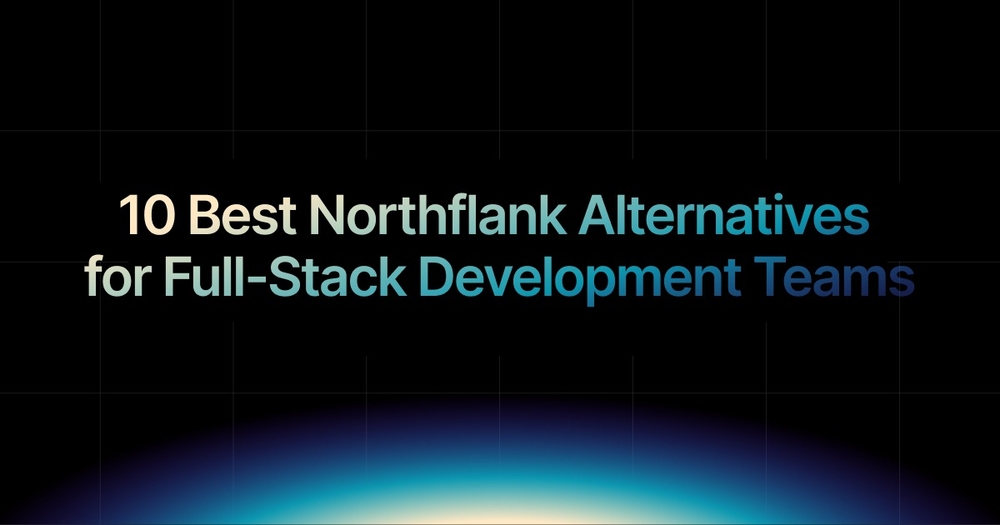
Introduction: Why Teams Are Searching for Northflank Alternatives
For many developers, Northflank has been a go-to choice for full-stack deployments, offering managed services, automation, and clean UI workflows. But as projects grow, so do the limitations. Teams often realise they need more scalability, pricing transparency, and flexibility than what Northflank can offer.
That’s why more developers are now searching for Northflank alternatives, platforms that combine automation, performance, and affordability without the heavy DevOps overhead.
The reality is simple: modern full-stack teams need more than just deployment.
They need built-in CI/CD, environment control, cost optimisation, and the ability to scale backend and frontend apps together, features that most single-purpose hosting platforms struggle to provide.
In this guide, we’ll explore the 10 best Northflank alternatives in 2025, comparing features, pricing, and scalability.
Whether you’re a startup launching your first product or an engineering team managing complex workloads, these alternatives will help you find a platform that fits your workflow better and saves you money while doing it.
Why Full-Stack Teams Need More Than Basic Deployment Tools?
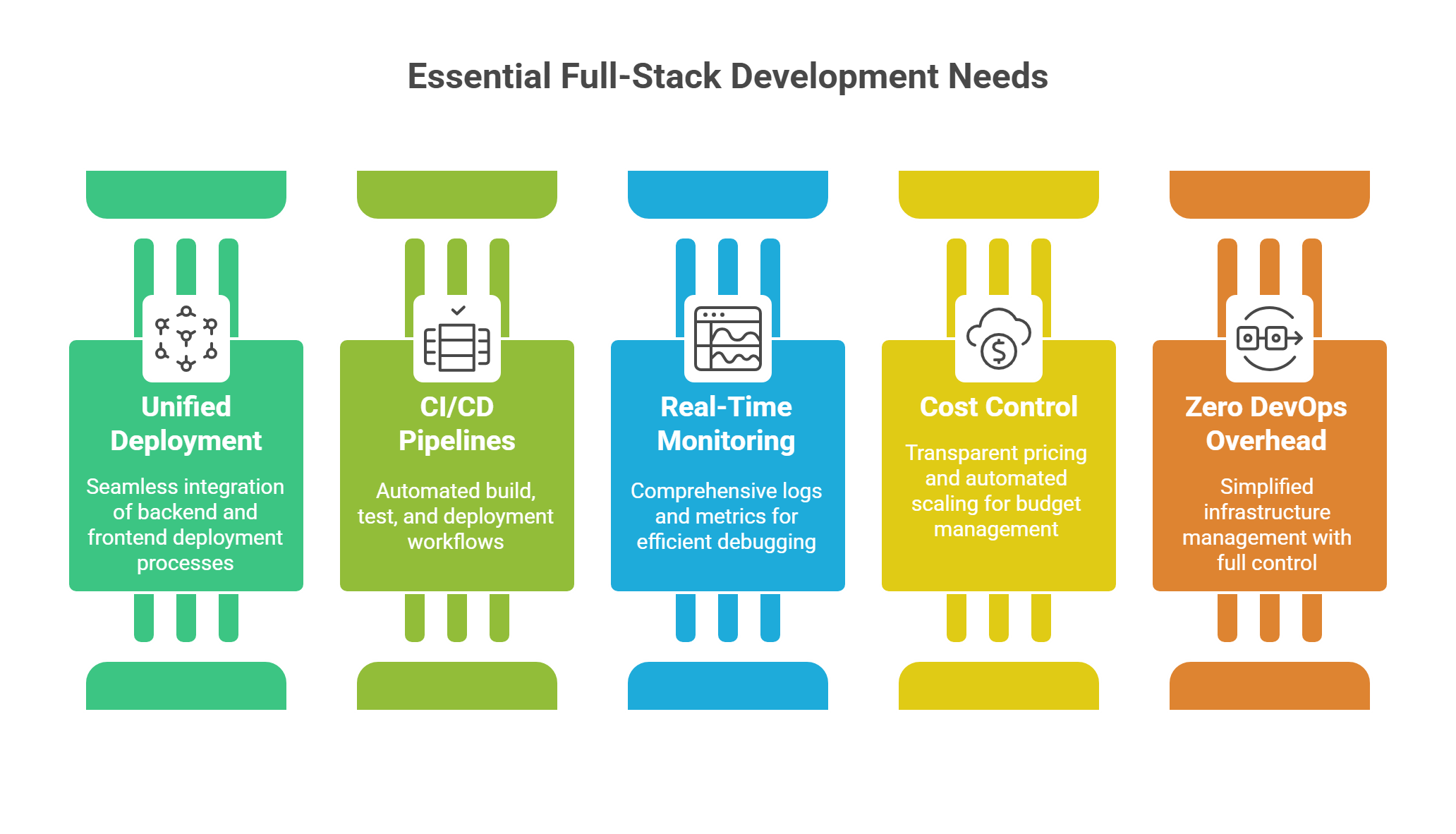 Modern development isn’t just about pushing code to production. It’s about managing an entire lifecycle from build to deployment to monitoring. And that’s exactly where many teams begin to outgrow Northflank and other basic deployment platforms.
Modern development isn’t just about pushing code to production. It’s about managing an entire lifecycle from build to deployment to monitoring. And that’s exactly where many teams begin to outgrow Northflank and other basic deployment platforms.
For small projects, Northflank’s managed environments and automation tools are convenient. But once teams start running full-stack applications, multiple microservices, APIs, databases, and frontend builds, they need a platform that can handle more complexity, flexibility, and performance.
Here’s what full-stack developers expect today that basic tools often miss:
1. Unified Backend + Frontend Deployment
Modern apps combine web frontends, APIs, and databases that need to work together. Managing them separately adds friction and costs. Platforms built for full-stack workflows make it possible to deploy everything in one flow, backend, frontend, and databases included.
2. Built-In CI/CD Pipelines
Continuous integration and delivery have become standard. Developers want to push code and let the platform handle building, testing, and deploying automatically. Tools without native CI/CD or Docker integration end up creating unnecessary steps and manual fixes.
3. Real-Time Monitoring and Logs
Debugging across multiple services is one of the hardest parts of scaling full-stack apps. Without built-in logs, alerts, and performance metrics, developers spend hours switching between dashboards instead of solving problems.
4. Cost Control and Predictable Scaling
As traffic grows, so does cloud usage, often unpredictably. Platforms with transparent pricing and automated scaling ensure teams can grow confidently without fear of surprise bills.
5. Zero DevOps Overhead
Full-stack teams want the flexibility of Kubernetes without the complexity of managing it. They prefer platforms that abstract the infrastructure while keeping full control over configuration, scaling, and performance.
Full-stack developers don’t just want a place to deploy code. They want a complete platform that automates the infrastructure around it.
10 Best Northflank Alternatives for 2025
The following platforms are among the best Northflank alternatives in 2025, chosen for their reliability, automation, scalability, and real-world fit for full-stack development teams.
Each one has its strengths, limitations, and ideal use cases
1. Kuberns: The AI-Powered Northflank Alternative for Full-Stack Teams
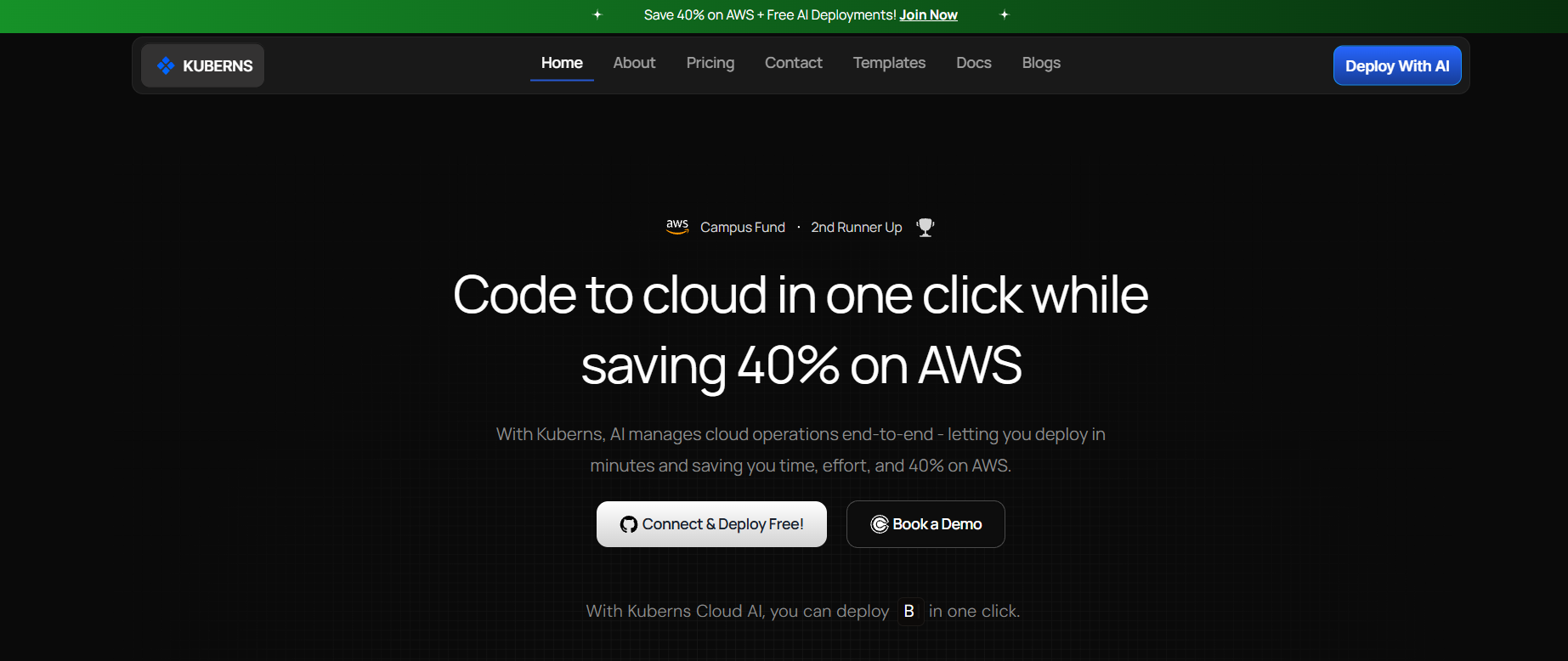 If you love Northflank’s simplicity but want more control, automation, and cost efficiency, Kuberns is the next step forward. It’s an AI-powered platform built on AWS that automates deployment, scaling, and infrastructure optimisation, giving full-stack developers everything they need in one place.
If you love Northflank’s simplicity but want more control, automation, and cost efficiency, Kuberns is the next step forward. It’s an AI-powered platform built on AWS that automates deployment, scaling, and infrastructure optimisation, giving full-stack developers everything they need in one place.
Key Highlights:
- One-click deployment directly from Git.
- Built-in CI/CD, monitoring, logs, and alerts.
- Auto-scaling and intelligent resource management to reduce waste.
- Up to 40% AWS cost savings.
- Zero DevOps setup. Ideal for startups and teams with limited infrastructure experience.
Why Users Switch to Kuberns:
Northflank is great for simple apps, but teams often hit scaling and cost limits as projects mature. Kuberns solves this with automation and transparent usage-based pricing, no per-user fees or hidden compute limits.
Verdict:
If you’re ready to grow beyond basic PaaS tools, Kuberns gives you production-grade infrastructure without the complexity.
2. Render: Easy Deployment but Limited Scaling Visibility
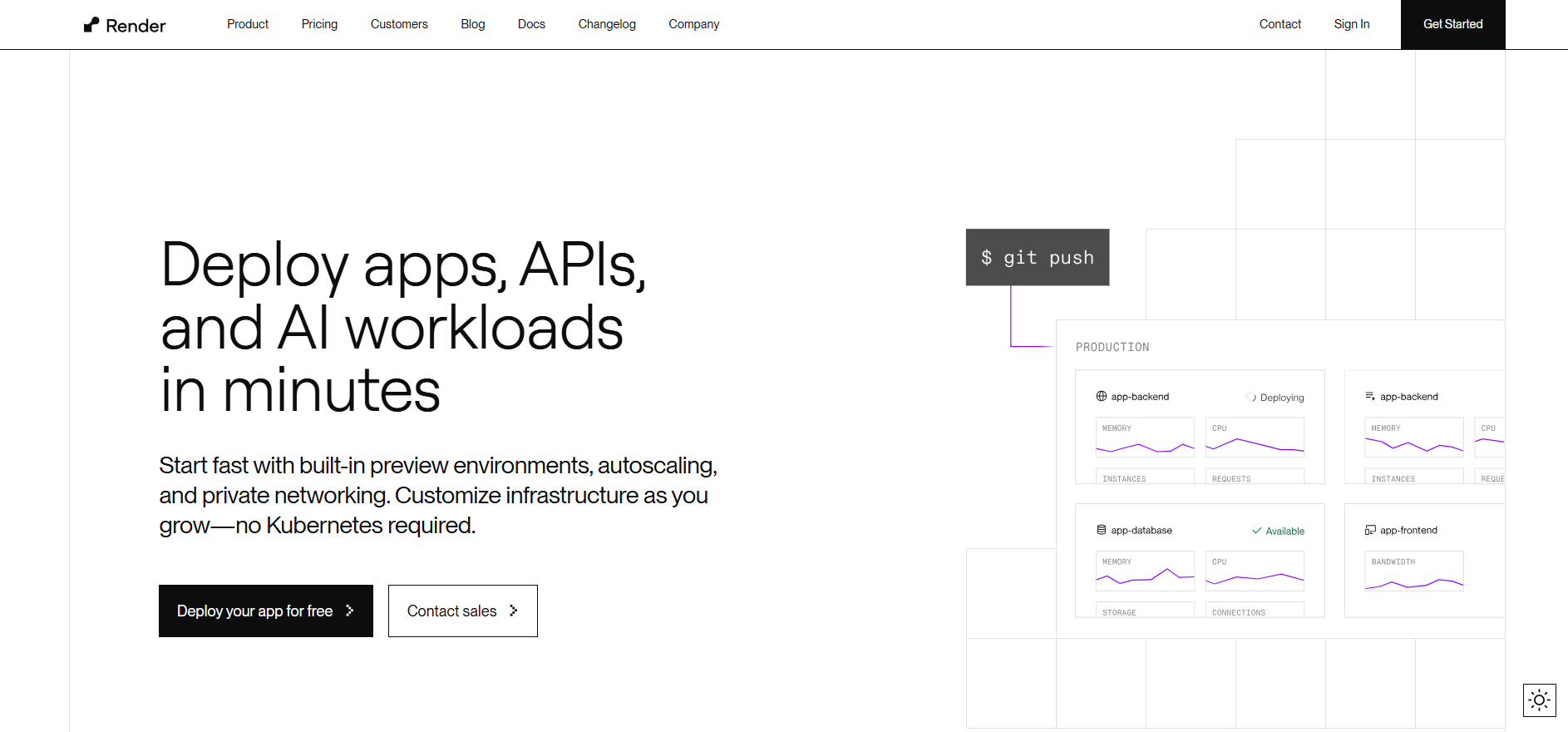 Render is known for its ease of use and quick Git deploys, making it a friendly option for small projects. It offers automatic builds, free SSL, and background workers similar to Northflank.
Render is known for its ease of use and quick Git deploys, making it a friendly option for small projects. It offers automatic builds, free SSL, and background workers similar to Northflank.
Strengths:
- Clean UI and instant deployments.
- Decent pricing for light apps.
- Supports custom domains and static sites.
Limitations:
- Limited control over infrastructure and networking.
- Scaling beyond a few services can be costly.
- No AI-based cost optimisation or in-depth analytics.
Verdict:
Render works well for lightweight apps, but teams needing advanced monitoring or budget control find more value with Kuberns and its 40% AWS savings advantage.
3. Railway: Fast Deployments with Limited Resource Flexibility
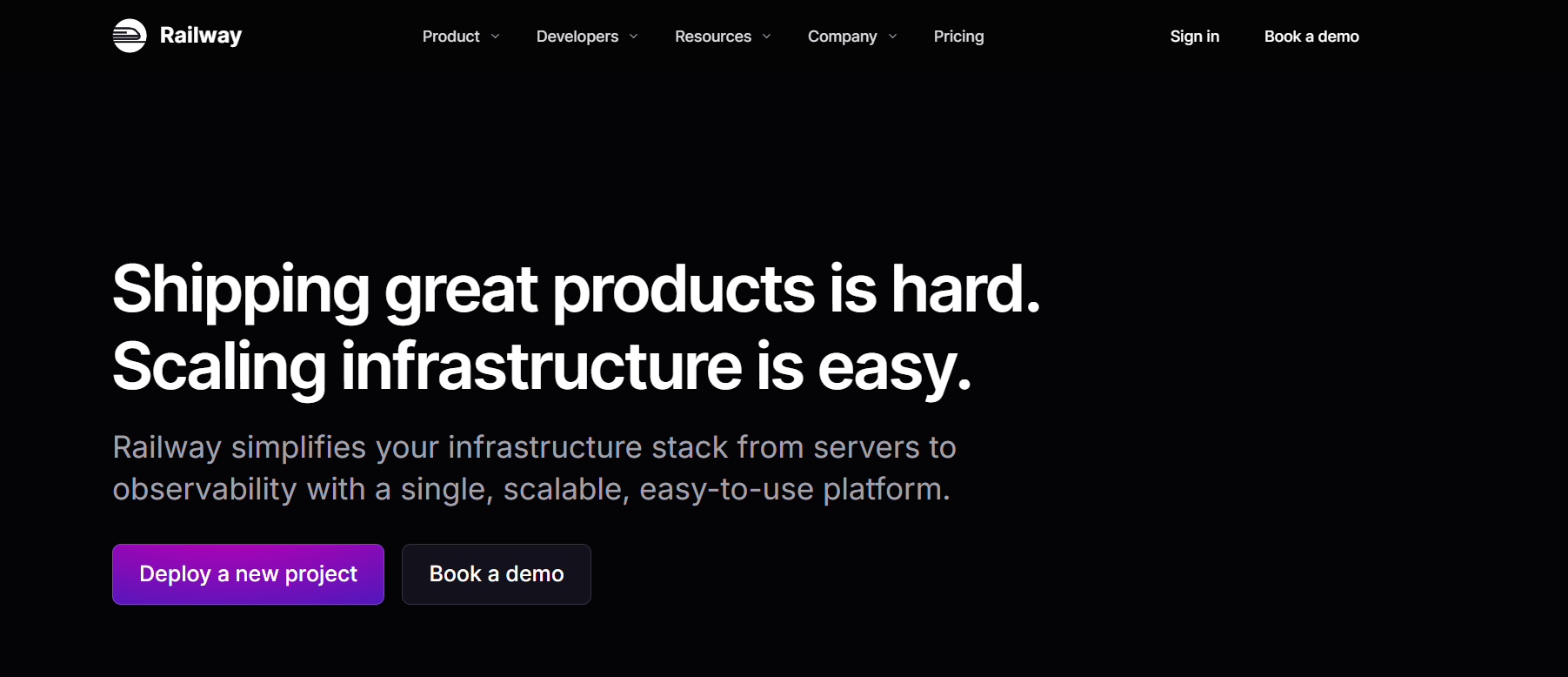 Railway is developer-friendly, offering quick deployments for Node, Python, and Go projects. It’s great for testing and MVPs, similar to Northflank’s free tier.
Railway is developer-friendly, offering quick deployments for Node, Python, and Go projects. It’s great for testing and MVPs, similar to Northflank’s free tier.
Strengths:
- One-click provisioning for databases.
- Good UI and GitHub integration.
- Low entry barrier for new developers.
Limitations:
- Limited resource configuration.
- Lack of visibility into usage metrics.
- Cost escalates rapidly at scale.
Verdict:
Railway is great for testing and learning, but for teams building long-term apps that require auto-scaling and monitoring, Kuberns offers a more mature infrastructure environment.
4. Fly.io: Edge Hosting with Manual Management
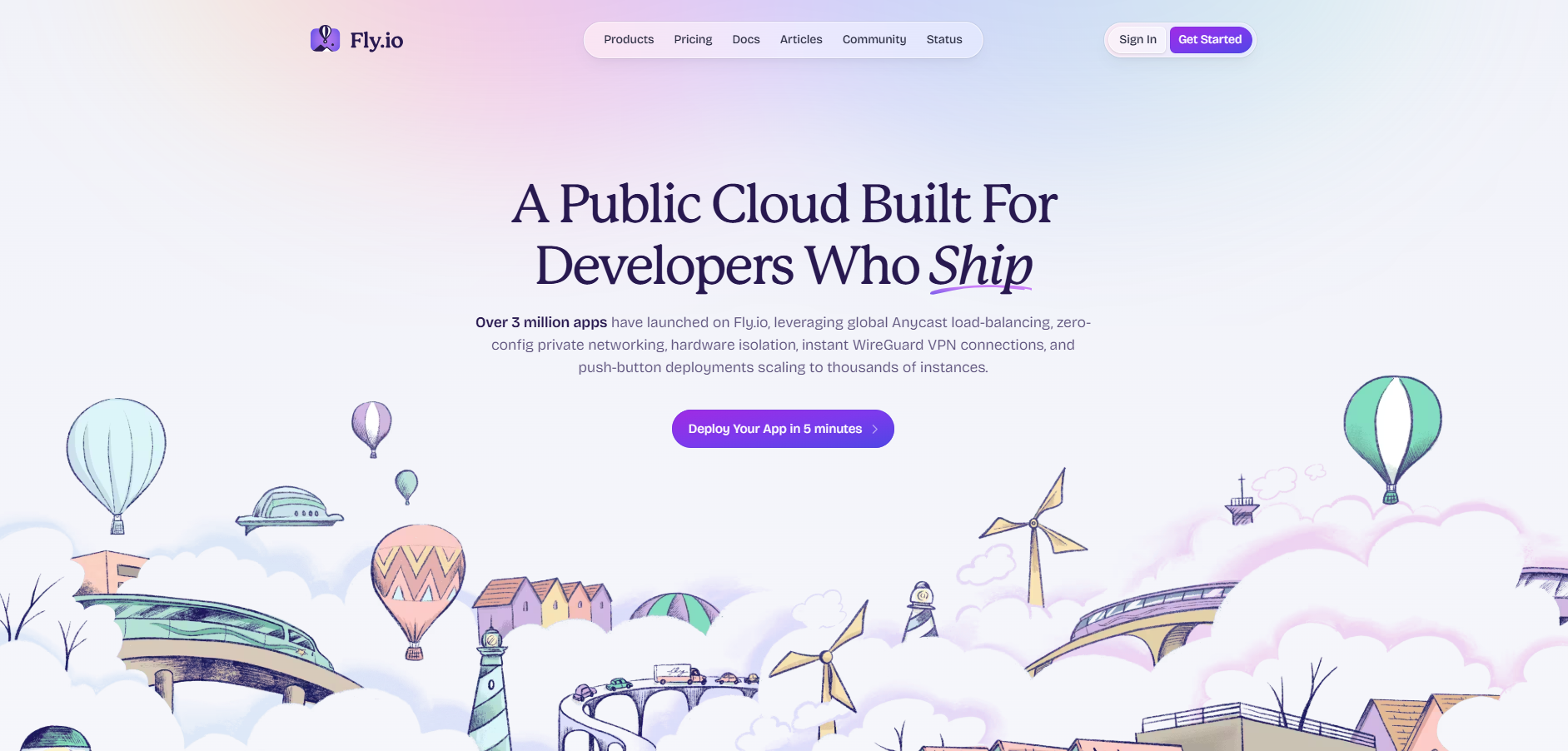 Fly.io lets developers deploy apps close to users using edge infrastructure. It excels at latency reduction but still requires manual infrastructure management and Docker expertise.
Fly.io lets developers deploy apps close to users using edge infrastructure. It excels at latency reduction but still requires manual infrastructure management and Docker expertise.
Strengths:
- Excellent for geo-distributed apps.
- Customizable networking and routing.
- Global presence with low latency.
Limitations:
- Steeper learning curve than Northflank.
- Complex scaling and debugging.
- Higher pricing for persistent workloads.
Verdict:
If you need edge performance and can manage a complex setup, Fly.io works. For developers wanting automated global scaling without manual ops, Kuberns provides the same reach through AWS regions with AI-driven deployment.
5. DigitalOcean App Platform: Familiar but Not Fully Automated
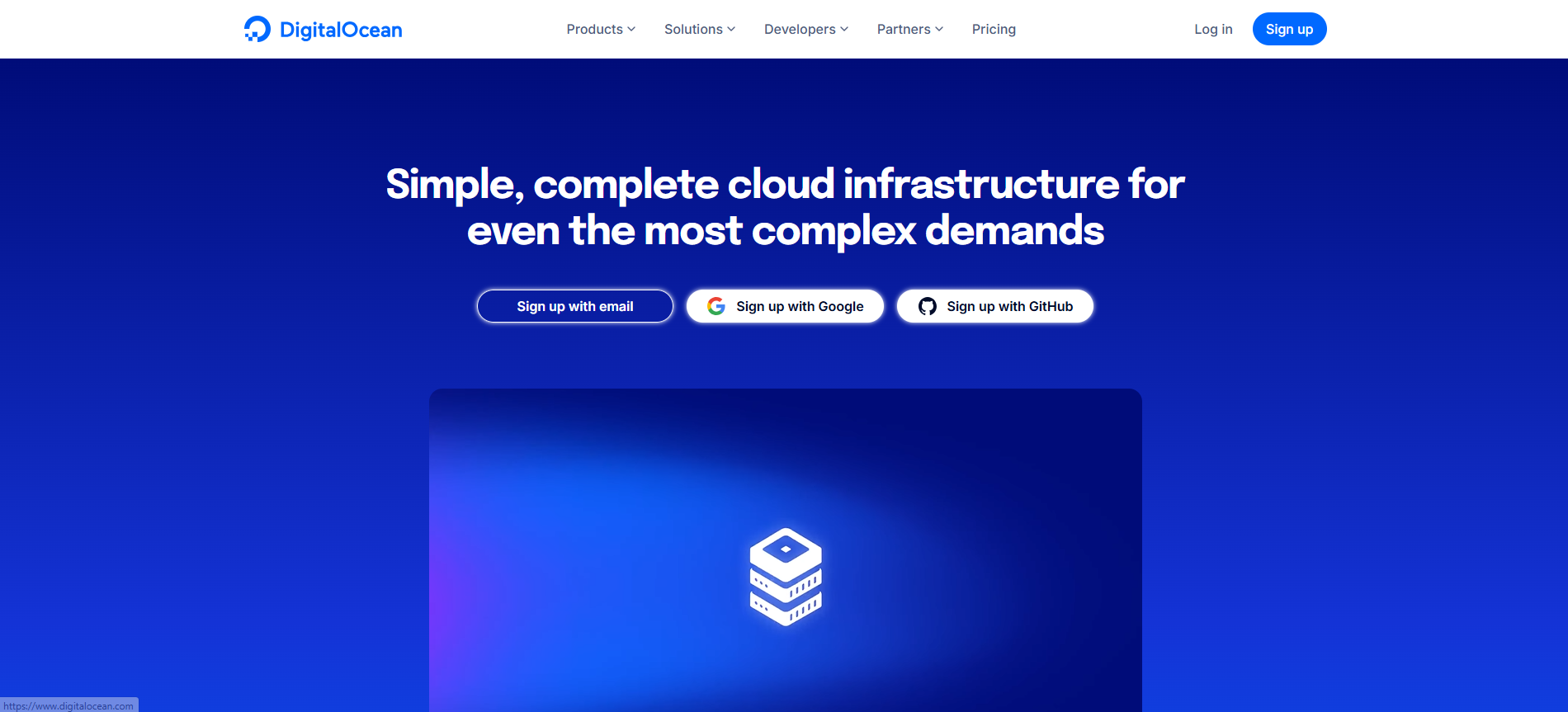 DigitalOcean App Platform is popular for its balance between simplicity and control. It’s a solid choice for small to mid-sized apps and a natural upgrade path from traditional VMs.
DigitalOcean App Platform is popular for its balance between simplicity and control. It’s a solid choice for small to mid-sized apps and a natural upgrade path from traditional VMs.
Strengths:
- Clean UI and developer-friendly docs.
- Affordable entry-level pricing.
- Built-in horizontal scaling and backups.
Limitations:
- Manual tuning for performance optimisation.
- No AI layer for cost savings or predictive scaling.
- Limited observability tools compared to new-gen platforms.
Verdict:
DigitalOcean remains reliable, but if you’re aiming for automation and deep cost control, Kuberns provides those capabilities out of the box, without requiring extra plugins or manual configurations.
6. Heroku: Still Simple, But Pricing and Scaling Are Pain Points
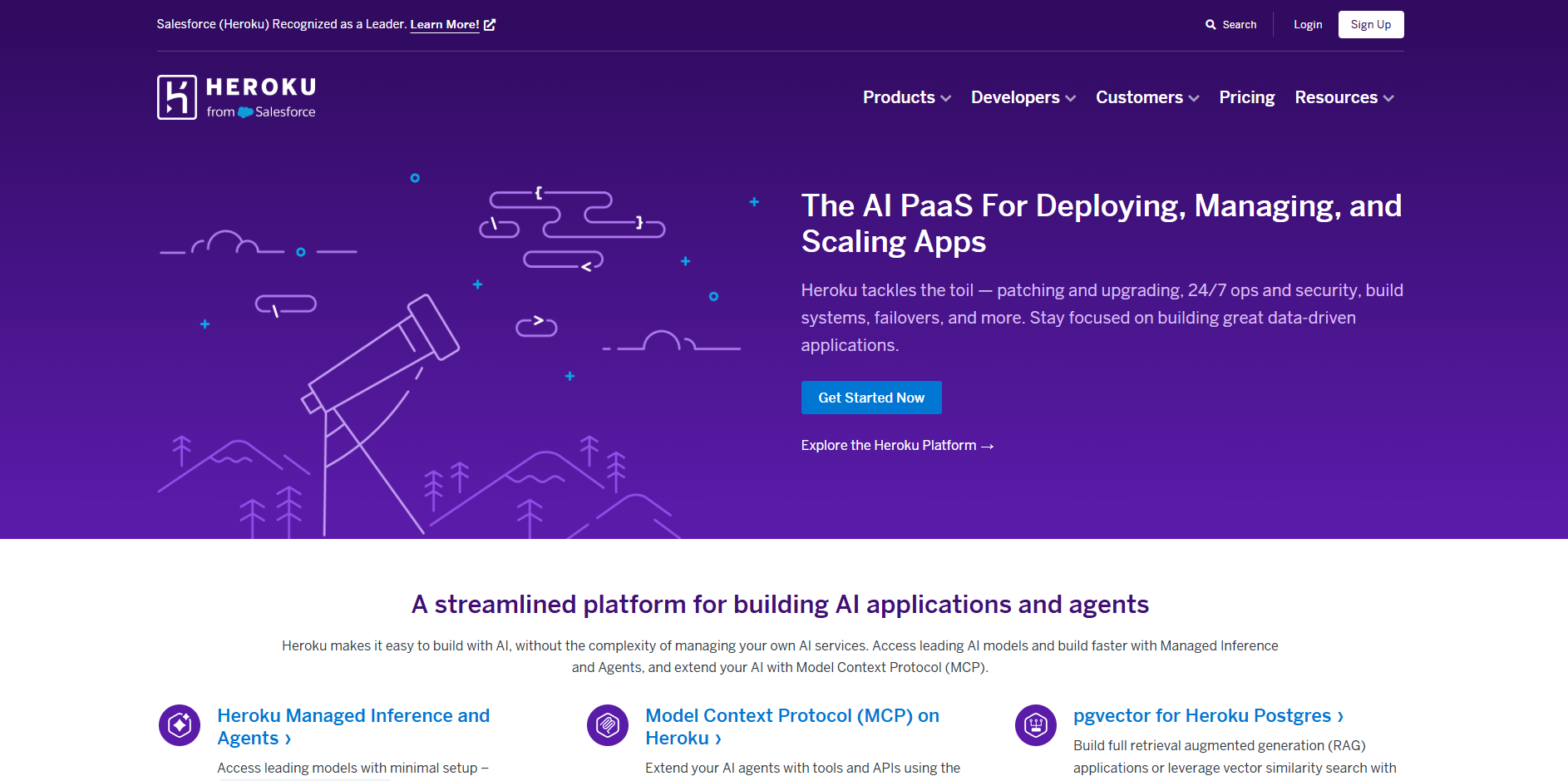 For years, Heroku defined developer-friendly deployment. It’s stable and well-documented, making it a familiar choice for many startups transitioning from Northflank.
For years, Heroku defined developer-friendly deployment. It’s stable and well-documented, making it a familiar choice for many startups transitioning from Northflank.
Strengths:
- Extremely easy setup and Git-based deploys.
- Large plugin marketplace.
- Good learning curve for new developers.
Limitations:
- Expensive once you leave the free tier.
- Limited control over networking and scaling behaviour.
- Add-on costs grow fast for production workloads.
Verdict:
Heroku remains beginner-friendly, but full-stack teams looking to scale beyond prototypes will hit pricing ceilings quickly. Kuberns delivers the same simplicity with AI-driven scaling and 40% lower infrastructure costs.
7. Vercel: Frontend Focused, Backend Limited
 Vercel is an excellent platform for frontend frameworks like Next.js, React, and Svelte. It integrates tightly with Git and automates deployment pipelines.
Vercel is an excellent platform for frontend frameworks like Next.js, React, and Svelte. It integrates tightly with Git and automates deployment pipelines.
Strengths:
- Best-in-class frontend deployment.
- Automatic preview environments.
- Seamless Git integration.
Limitations:
- Designed primarily for frontend hosting.
- Backend APIs and databases require external setup.
- Pay-as-you-go costs can grow unpredictably for heavy usage.
Verdict:
Vercel shines for static and edge-rendered frontends but lacks full-stack orchestration. Kuberns covers both frontend and backend services in one dashboard, making it more efficient for teams managing complete app lifecycles.
8. Qovery: Advanced Features with Complex Setup
 Qovery targets experienced DevOps and development teams seeking cloud flexibility with Kubernetes under the hood.
Qovery targets experienced DevOps and development teams seeking cloud flexibility with Kubernetes under the hood.
Strengths:
- Multi-cloud deployment (AWS, Azure, GCP).
- Environment isolation for dev/stage/prod.
- Strong integration with Terraform and Helm.
Limitations:
- Complex configuration for non-DevOps users.
- Pricing depends on the infrastructure layer chosen.
- Requires Kubernetes understanding for full control.
Verdict:
Qovery is powerful but better suited for DevOps-heavy organisations. For developers who want that power without the learning curve, Kuberns provides a similar AWS-backed foundation managed entirely by AI automation.
9. Google Cloud Run: Reliable but Technical
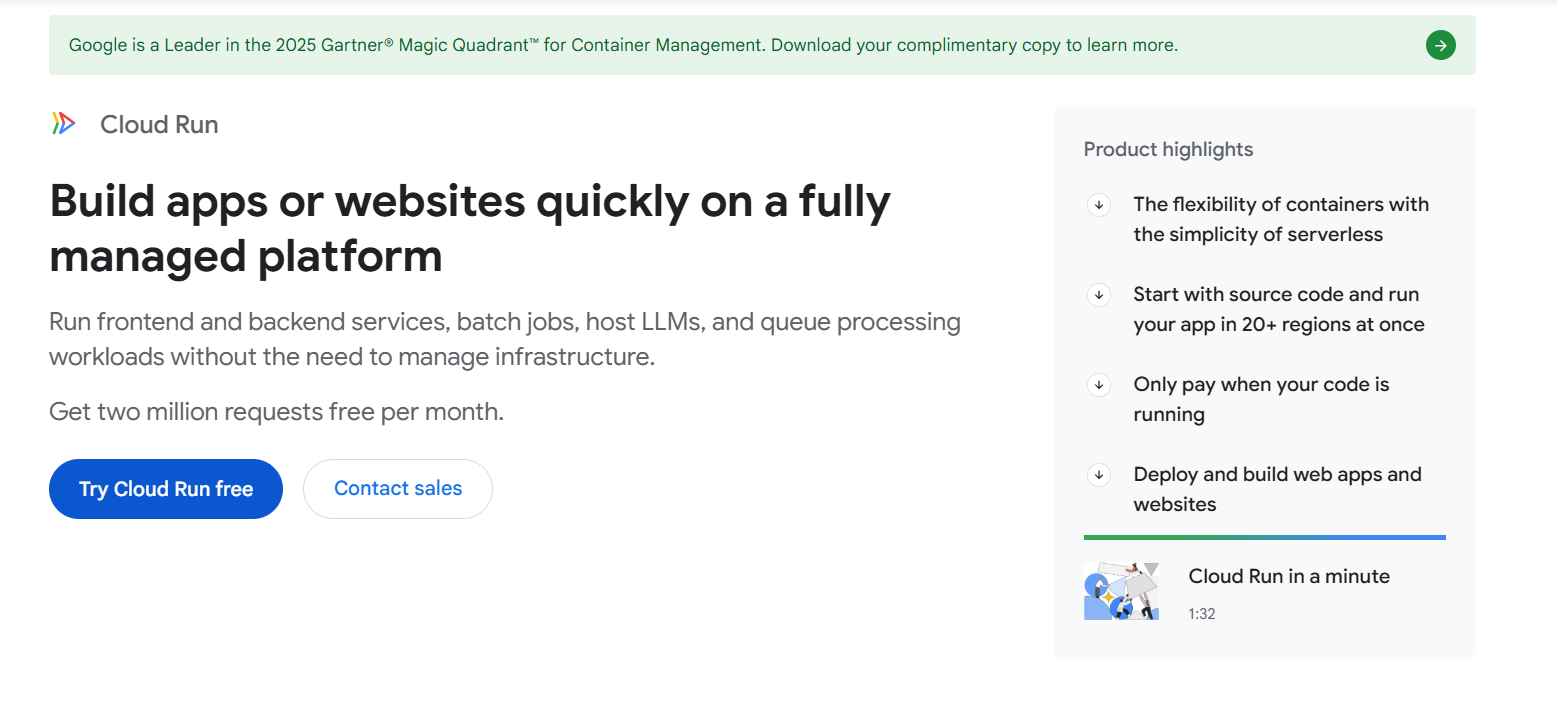 Google Cloud Run is a managed serverless platform that lets developers run containerized apps directly on Google Cloud. It’s stable and enterprise-ready but requires understanding of GCP tooling, IAM roles, and networking setup.
Google Cloud Run is a managed serverless platform that lets developers run containerized apps directly on Google Cloud. It’s stable and enterprise-ready but requires understanding of GCP tooling, IAM roles, and networking setup.
Strengths:
- Fully managed serverless infrastructure.
- Excellent performance and global reach.
- Pay only for active requests.
Limitations:
- Complex IAM and network configurations.
- Requires knowledge of Google Cloud ecosystem.
- Less intuitive for developers without cloud experience.
Verdict:
Google Cloud Run is great for enterprises already invested in GCP. But if you’re looking for the same reliability with simpler setup, transparent pricing, and AI-powered scaling, Kuberns is a better fit for modern full-stack teams.
10. AWS Amplify: Powerful but Complex for Small Teams
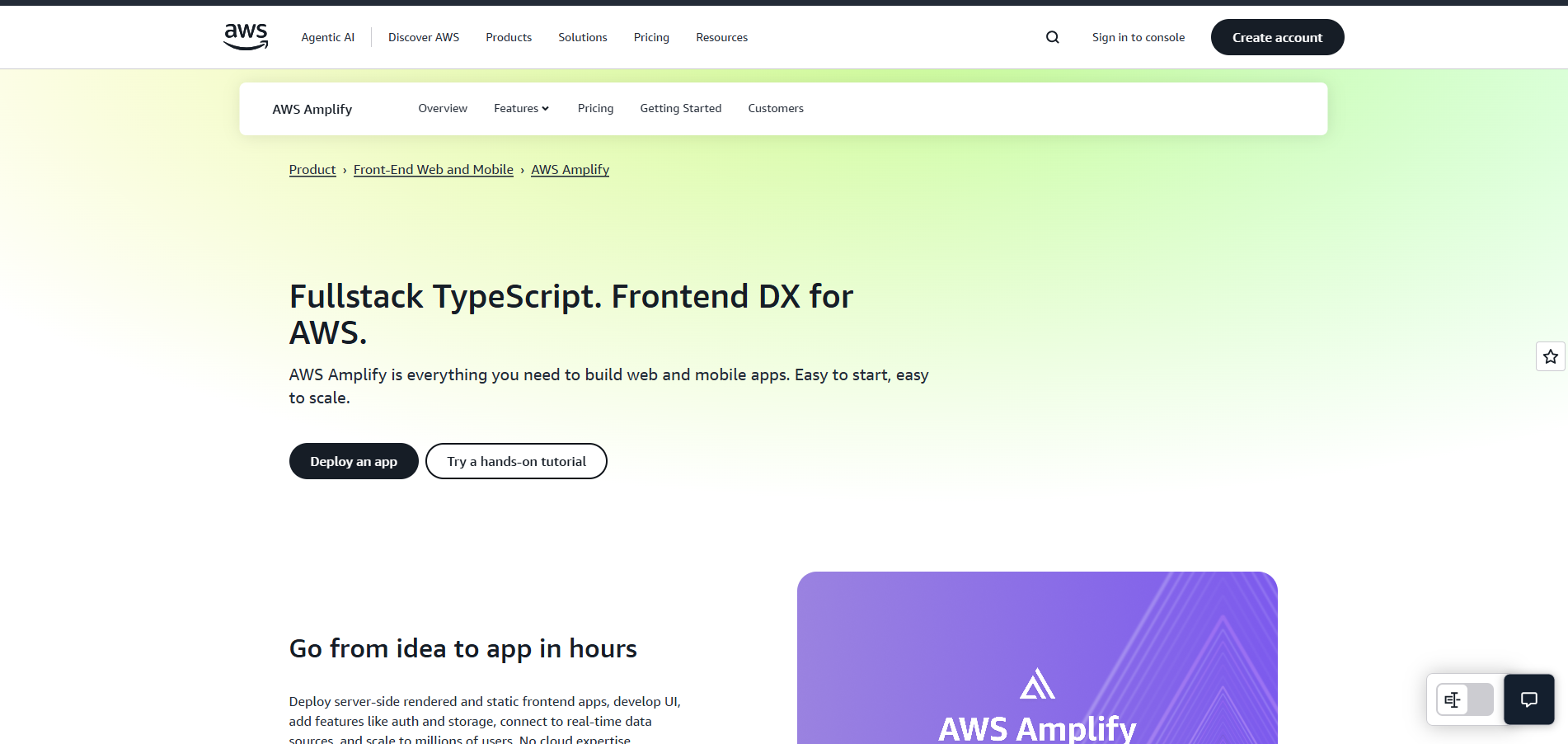 AWS Amplify provides deep integration with the AWS ecosystem and supports web + mobile development. It’s robust, but configuration complexity can overwhelm smaller teams.
AWS Amplify provides deep integration with the AWS ecosystem and supports web + mobile development. It’s robust, but configuration complexity can overwhelm smaller teams.
Strengths:
- Tight integration with AWS services.
- Supports serverless, APIs, and static sites.
- Enterprise-grade scalability and uptime.
Limitations:
- Steep learning curve.
- Requires manual setup of roles, permissions, and pipelines.
- Pricing can be confusing for non-AWS experts.
Verdict:
Amplify delivers serious scalability but demands AWS expertise. Kuberns, built on AWS, simplifies all of that, offering the same reliability with one-click deploys and automated optimisation, making it ideal for full-stack teams who just want results.
Summary Table: Top Northflank Alternatives
Choosing the right Northflank alternative ultimately depends on the tech stack and growth stage. Some tools excel at quick front-end hosting, while others excel at handling complex backend workloads.
But for most full-stack teams, the challenge isn’t just where to host, it’s how to manage deployments, scaling, and cloud bills efficiently without adding DevOps overhead.
| Platform | Best For | Strength | Limitation | Ideal User |
|---|---|---|---|---|
| Kubernetes | Full-stack teams | AI-driven scaling & 40% cost savings | None for managed use | Startups, SMBs, Enterprises |
| Render | Simple apps | Easy UI | Limited scaling | Small projects |
| Railway | MVPs & tests | Quick deploys | Lacks monitoring | Indie developers |
| Fly.io | Edge apps | Global performance | Manual management | Distributed apps |
| DigitalOcean App Platform | SMEs | Simple deployment | Manual optimization | Mid-size teams |
| Heroku | Early-stage projects | Simplicity | Expensive at scale | Startups |
| Vercel | Frontend | Top-tier UI | Weak backend support | Frontend teams |
| Qovery | DevOps-heavy orgs | Multi-cloud | Complex setup | Enterprises |
| Google Cloud Run | Serverless workloads | Reliable and scalable | Technical setup | GCP users |
| AWS Amplify | Enterprise apps | AWS ecosystem | High learning curve | Large teams |
Why Kuberns Stands Out for Full-Stack Development Teams?
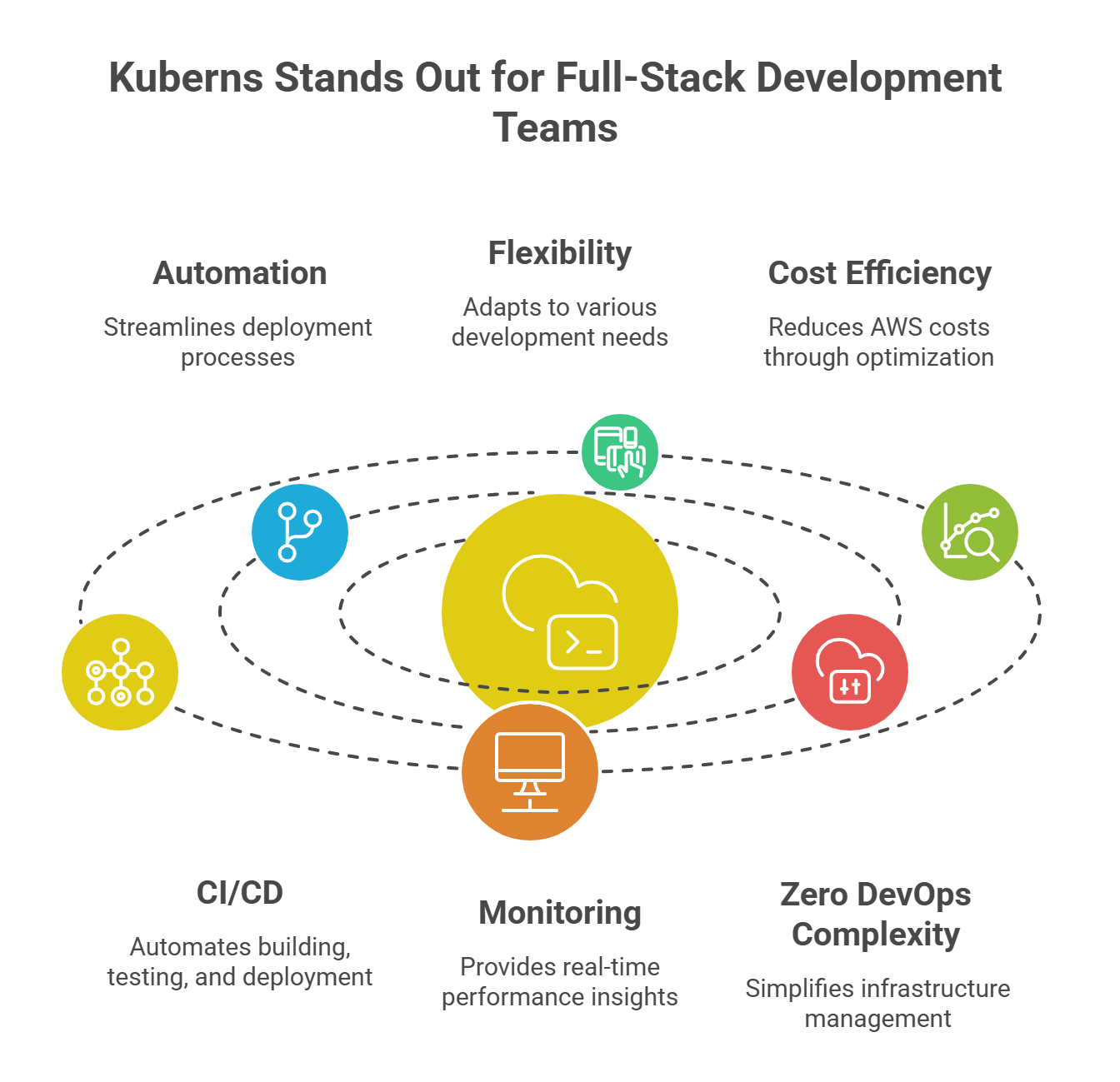
Among all the Northflank alternatives, one platform consistently checks every box that full-stack teams look for Kuberns. It combines the automation of a PaaS, the flexibility of Kubernetes, and the cost efficiency of an AI-powered infrastructure manager.
Most deployment tools stop at helping you push code.
Kuberns goes further, managing everything from CI/CD to scaling, monitoring, and cost optimisation, without needing you to configure a single pipeline or server manually.
One-Click Deployment That Just Works
Full-stack developers don’t want to spend hours configuring YAML files or Docker builds. With Kuberns, deployment is truly seamless. Connect your Git repository, choose your branch, and deploy instantly.
The platform automatically handles containerization, networking, SSL setup, and scaling rules.
Whether you’re deploying a React frontend with a Node backend or a Python API with a PostgreSQL database, everything launches in one unified flow, no DevOps setup, no complex CLI commands.
Built-In CI/CD and Automated Scaling
Kuberns comes with a built-in CI/CD pipeline that automates the entire process of building, testing, and deploying code changes. Every commit triggers a new build, and the system intelligently scales resources based on live traffic and CPU utilisation.
This ensures apps stay responsive during peak traffic and scale down automatically during low usage, saving time and cloud spend without manual intervention.
Up to 40% AWS Cost Savings by Default
While Northflank and most PaaS tools charge fixed rates or per-user fees, Kuberns optimises every deployment for real usage.
Its AI engine continuously monitors resource consumption and adjusts compute, memory, and storage allocation in real time.
This intelligent scaling leads to up to 40% savings on AWS costs, without compromising performance or uptime.
For teams running multiple environments, the cost impact is even greater, since the platform automatically minimises idle resources.
Complete Visibility with Integrated Monitoring and Logs
One of the biggest developer pain points with traditional PaaS tools is visibility. Kuberns solves that with built-in monitoring, logs, and alerting.
Developers can view performance metrics, error logs, and usage trends from a single dashboard, no third-party monitoring setup required.
This helps teams debug faster, maintain stability, and understand exactly how each deployment performs across environments.
Zero DevOps Complexity
Traditional infrastructure setups require managing CI/CD tools, load balancers, autoscaling groups, and cloud permissions. Kuberns eliminates that layer entirely. It abstracts the complexity of Kubernetes and AWS, giving developers the control they need without the maintenance burden.
You still get Kubernetes-level power, but through a simple UI where everything, environments, scaling, domains, and logs, is handled automatically.
Built for Every Stage of Growth
From early-stage startups to large enterprises, Kuberns adapts to how your team scales. You can start small with a few containers and grow to multiple microservices without changing your deployment process. Because it runs on AWS infrastructure, you also get enterprise-grade security, uptime, and compliance out of the box.
The Result: Speed, Simplicity, and Savings
Full-stack teams choose Kuberns because it gives them the trifecta every developer wants: faster deployment, easier scaling, and lower cloud bills.
It turns complex infrastructure management into a single automated workflow.
If you’re comparing Northflank alternatives, Kuberns is the one platform that delivers the simplicity of PaaS, the scalability of Kubernetes, and the intelligence of AI, all in one place.
Start your deployment on Kuberns
How to Choose the Right Northflank Alternative for Your Team?
Finding the right Northflank alternative isn’t just about features. It’s about how well a platform fits your workflow, your scale, and your budget. Every team has unique priorities, but there are three key factors that make the biggest difference when choosing the right deployment platform.
1. Match the Platform to Your Workflow
Before comparing pricing or features, start with how your team works. If you manage both frontend and backend deployments, you need a unified environment that supports multiple frameworks, CI/CD pipelines, and automatic scaling.
Platforms designed for single-purpose hosting might look simple at first but often create silos as projects grow.
2. Evaluate Long-Term Cost and Scalability
Many teams switch from Northflank because their costs increase as traffic grows. Platforms that charge per seat or per instance can look affordable early on but become unpredictable later.
Choose a solution with usage-based billing and automated cost control.
This approach ensures your infrastructure scales with your user base, not your budget.
3. Look for Automation That Saves Time, Not Adds Complexity
It’s easy to confuse “features” with “efficiency.”
A platform can have endless options, but if every deployment requires manual configuration or scripting, your team spends more time managing infrastructure than building products.
The right platform should automate the critical but repetitive parts of DevOps, CI/CD, scaling, monitoring, and backups, while giving you control over key configurations.
Final Verdict: Build Faster, Deploy Smarter, Scale Effortlessly
As the developer ecosystem evolves, teams are no longer looking for tools that just deploy code, they’re looking for platforms that understand growth. And that’s the main reason so many developers are exploring Northflank alternatives today.
Each platform on this list offers something unique: Heroku’s simplicity, Vercel’s frontend focus, Fly.io’s edge reach, Qovery’s multi-cloud flexibility, but none bring together everything that modern full-stack teams need in one place.
That’s where Kuberns stands out.
Whether you’re an early-stage startup or an enterprise team managing multiple environments, Kuberns gives you what every developer really wants: less infrastructure to manage and more time to build.
So if you’re evaluating Northflank alternatives, the smartest choice isn’t just another platform, it’s a faster, easier, and more intelligent way to deploy.

Frequently Asked Questions
1. What are the best Northflank alternatives in 2025?
Some of the best Northflank alternatives in 2025 include Kuberns, Render, Railway, Fly.io, DigitalOcean App Platform, Heroku, Vercel, Qovery, Google Cloud Run, and AWS Amplify. Among them, Kuberns stands out for its AI-powered automation, AWS-based reliability, and up to 40% lower infrastructure costs.
2. Why do developers look for alternatives to Northflank?
While Northflank offers simplicity, developers often switch because of limited scaling flexibility, pricing complexity, and a lack of advanced automation. Modern full-stack teams prefer platforms that integrate CI/CD, monitoring, and cost optimisation in one environment, something Kuberns provides by default.
3. How does Kuberns compare to Northflank?
Kuberns simplifies everything Northflank does and automates what it doesn’t. It offers one-click deployments, built-in CI/CD pipelines, AI-based scaling, and transparent AWS-backed pricing. Unlike Northflank, Kuberns automatically monitors and optimises infrastructure to keep performance high and costs low.
4. Can I migrate my projects from Northflank to Kuberns easily?
Yes. Migrating to Kuberns is straightforward. You can connect your Git repository directly, deploy your services, and let the platform handle containerization, scaling, and monitoring automatically. The process typically takes just a few minutes, and you can run both environments in parallel during migration to avoid downtime.
5. Which Northflank alternative is best for full-stack teams?
For full-stack developers managing both backend APIs and frontend apps, Kuberns offers the most complete solution. It supports multiple frameworks, automates scaling, integrates logging and monitoring, and keeps infrastructure costs predictable, all in one platform.
6. Does Kuberns work for enterprises as well as startups?
Absolutely. Kuberns is designed to scale with your business. Startups use it for quick MVP launches without DevOps setup, while enterprises rely on it for large-scale, multi-environment deployments with full visibility, compliance, and cost control.
7. How much can Kuberns reduce infrastructure costs compared to other platforms?
Kuberns uses an AI-based optimisation layer to manage resource allocation in real time. By right-sizing compute and storage automatically, teams typically save up to 40% on AWS costs while maintaining the same or better performance compared to traditional PaaS platforms.